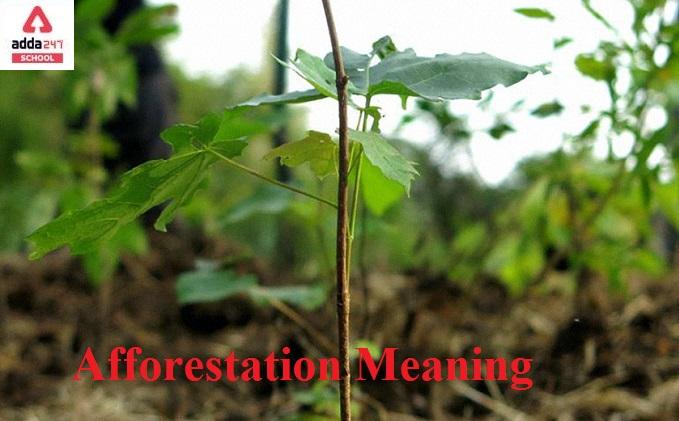Table of Contents
Meaning of Afforestation
Afforestation Meaning and Definition is explained here. Afforestation is the process of planting a forest or grove of trees in an area that previously had no trees. Many government and non-governmental groups are directly involved in afforestation efforts to improve carbon capture and develop forests. Afforestation is becoming a more popular strategy for combating climate change because it is known to improve soil quality and organic carbon levels in the soil, preventing desertification.
Read About Biodiversity
Afforestation Meaning in Hindi
जिस क्षेत्र में पहले कोई वृक्ष नहीं था, वहां जंगल या पेड़ों के उपवन की खेती को वनीकरण के रूप में जाना जाता है। कई सरकारी और गैर-सरकारी समूह कार्बन कैप्चर में सुधार और वनों के विकास के लिए वनीकरण के प्रयासों में सीधे शामिल हैं। जलवायु परिवर्तन का मुकाबला करने के लिए वनरोपण एक अधिक लोकप्रिय रणनीति बन रही है क्योंकि यह मिट्टी की गुणवत्ता और मिट्टी में कार्बनिक कार्बन के स्तर में सुधार करने के लिए जाना जाता है, जिससे मरुस्थलीकरण को रोका जा सकता है।
Read About Global Warming
Afforestation meaning in terms of Environment
The process of afforestation begins with the identification of a suitable location. Climate, soil, vegetation, and human activity are only a few of the site’s environmental elements that must be investigated. These criteria will define the site’s quality, which tree species should be planted, and how the trees should be placed.
Following the analysis and selection of the forest site, the area must be readied for planting. Chopping, mounding, bedding, herbicides, and prescribed burning are some of the mechanical and chemical processes used in preparation. Planting might begin when the site has been prepped. Direct seeding, which involves putting seeds directly onto the forest floor, is one form of planting.
Another alternative is seedling transplanting, which again is similar to direct seeding but with the added bonus of a root system. For tree species that can reproduce asexually, a portion of a tree stem, branch, root, or leaves can be planted on the forest floor and sprout successfully, afforestation by cutting is an alternative. Special tools, such as a tree planting bar, are often used to make tree planting easier and faster.
Read About Economic activities impact on Environment
Reafforestation in India
Forests cover 23% of India’s land area. India’s total forest and tree cover climbed to 24.39 per cent, or 8,020. 88 km2, in 2018. Based on biophysical parameters, India’s forests are divided into five broad categories and 16 kinds. Subtropical dry deciduous trees make up 38% of the forest, tropical moist deciduous trees make up 30%, and various smaller groups make up the balance. In a given area, only native species are planted. Fruit-bearing trees are preferred whenever possible due to their ability to provide sustenance.
In the Indian state of Uttar Pradesh, Indians planted 220 million trees in a single day in 2019. Mr Narendra Modi, India’s Prime Minister, allocated Rs. 47, 436 crores to various states for compulsory afforestation efforts on Thursday, August 29, 2019. The funds can be used for catchment area treatment, assisted natural generation, forest management, wildlife protection and management, village relocation from protected areas, human-wildlife conflict management, training and awareness generation, supply of wood-saving devices, and other related activities.
As part of India’s attempts to tackle climate change, increasing tree cover will help provide extra carbon sinks to satisfy the nation’s Intended Nationally Determined Contribution of 2.5 to 3 billion tonnes of carbon dioxide equivalent through more forest and tree cover by 2030. The Maharashtra government planted around 20 million saplings across the state and plans to plant another 30 million next year. The Indian government has set aside $6.2 billion for tree planting in order to promote “forestation in line with accords made at the Paris climate change summit in 2015,” according to The Telegraph. The CAMPA law was also passed by the Indian government.
Define Afforestation for class 5 to 10
Afforestation has numerous climate-related advantages. Several new studies suggest that forests attract rain, which could explain why droughts are more common in places of the world where trees are sparse, such as western Africa.



 CUET UG Date Sheet 2025 @cuet.nta.nic.in...
CUET UG Date Sheet 2025 @cuet.nta.nic.in...
 UP, MP, CBSE Board Result 2025 Live Upda...
UP, MP, CBSE Board Result 2025 Live Upda...
 NTA NEET Cut Off 2025, Expected Cutoff f...
NTA NEET Cut Off 2025, Expected Cutoff f...










